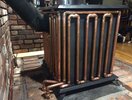- Joined
- 16 Oct 2021
- Messages
- 26
- Reaction score
- 0
- Country

Hi All ,
I am contemplating "hanging" a radiator on the rear of our 12kw Stovax woodburner then plumbing this into the CH system.
Our setup comprises an oil fired open vented system serving several rads and DHW tank , we live in the middle of knowhere and our firewood is free.
we are not looking to circulate a great amount of heat round the rads , however a small amount would be enough just to keep the cooler rooms of the house comfortable without having to run the oil boiler.
To me it makes sense if we could pump a small amount of heat around the system and save our oil , the wood burner is lit most days .
Anybody got any thoughts on this id be very interested the hear them , Thanks .
I am contemplating "hanging" a radiator on the rear of our 12kw Stovax woodburner then plumbing this into the CH system.
Our setup comprises an oil fired open vented system serving several rads and DHW tank , we live in the middle of knowhere and our firewood is free.
we are not looking to circulate a great amount of heat round the rads , however a small amount would be enough just to keep the cooler rooms of the house comfortable without having to run the oil boiler.
To me it makes sense if we could pump a small amount of heat around the system and save our oil , the wood burner is lit most days .
Anybody got any thoughts on this id be very interested the hear them , Thanks .


